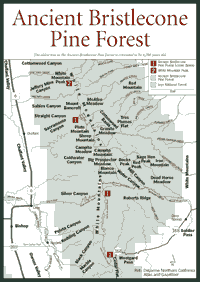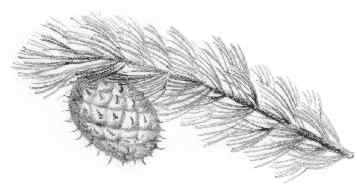 Ancient
Bristlecone Pine Forest And Scenic Byway
Ancient
Bristlecone Pine Forest And Scenic Byway  Ancient
Bristlecone Pine Forest And Scenic Byway
Ancient
Bristlecone Pine Forest And Scenic Byway [Fig. 45(1)] The White Mountains east of the Owens Valley are not in the Sierra Nevada, nor are they particularly easy to reach on Highway 168 and the White Mountain Road, a scenic byway that becomes a dirt road at one point. But there's a real good reason to take a full day out of the Sierra and journey across the desert to this arid, desolate-looking range: the bristlecone pine (Pinus longaeva), the oldest organism known.
Visitors should be aware that in this distant and forbidding mountain range, there are no gas stations or restaurants. You can find restrooms, picnic areas, a visitor's center, and trailhead camping at 14,246-foot White Mountain Peak, but there are no services here. Bring water and food for the trip to see these old trees.
The oldest tree, named after Methuselah, an Old Testament symbol of longevity in the Bible, is estimated to be 4,700 years old. If the estimates are true, this tree was alive 2,700 years before Christ was born.
Bristlecones grow in Utah and Nevada, and a related species, Pinus aristata, grows in Arizona. But there are more of these squat, twisted conifers growing in the White Mountains—the 58,000-acre Ancient Bristlecone Pine Forest—than anywhere else.
Science has been studying the trees since the 1950s when researcher Edmund Schulman first discovered the trees' age. The University of California White Mountains Research Station, north of the Schulman Grove, has pieced together a climate record dating back almost 9,000 years by examining and counting the tree rings on dead bristlecone pines.
 The
bristlecone's dead wood can linger in the ecosystem for thousands of years
because of the dense cell structure. Parts of a bristlecone pine can continue
living even after most of the tree has died.
The
bristlecone's dead wood can linger in the ecosystem for thousands of years
because of the dense cell structure. Parts of a bristlecone pine can continue
living even after most of the tree has died.
Research also indicates bristlecones have evolved for the harsh conditions of the White Mountains, preferring the soils where there is less competition for the nutrients. The dry alkaline soils in the White Mountains accommodate those needs well. The soils do not support a lot of vegetation. The bristlecones send out a wide, shallow root system to gather all the nutrients available for their slow growth—about 1 inch in diameter per century on exposed, steep hills. Sheltered bristlecones in comparatively good soil do not live half as long as those that get far less moisture or nutrients.
The trees contort in the high winds, which have blown sand and ice around these trees for centuries. They grow no higher than 25 or 30 feet. Their wood becomes almost golden with age. Photographers love what they see—the stark mountains and these golden, ancient trees.
The bristlecone is not the only tree in the forest. The closest tree species, limber pine (Pinus flexilis) resembles the bristlecone, but it does not have bristles on its cones. The limber pine's needles are slightly longer than the bristlecone's 2-inch needles. And, generally, neither species is grouped very closely with the other.
The drive to the forest is interesting but slow. The winding road goes about 25 miles from Owens Valley. It passes from the high desert scrub to pinion-juniper woodland to higher or montane vegetation before reaching the bristlecone pine forest above 9,500 feet. Do not expect to drive up White Mountain Road in the winter. Snowfall closes the road periodically from November to May.
The slower driving speeds will allow visitors to see some of the same wildlife that can be found in the different life zones or elevations of the Eastern Sierra. As the road moves up the slope, look for one-awned spineflower (Chorizanthe uniaristata) in sandy or gravelly areas. Higher up, visitors will see mountain sorrel (Oxyria digyna) and mountain clover (Trifolium wormskioldii), especially in July and August.
For bird watchers, the sights become interesting as the road approaches ridgelines where golden eagles (Aquila chrysaetos) and white-throated swifts (Aeronautes saxatillis) seem to float high above their prey. Also look for mountain bluebirds (Sialia currucoides) and mountain chickadee (Parus gambeli).
The first recommended stop on the drive is Sierra View Overlook at 9,000 feet. The display at the overlook helps people identify the 100 miles of the Sierra visible from this location. Mount Whitney can be seen from this spot.
Ten miles down the road, there is a visitor's center at the Schulman Grove where people can get information or have a picnic. The grove has two self-guided trails—the Discovery Trail and the Methuselah Trail. On the 1-mile Discovery Trail, people will pass the Pine Alpha tree, the first tree Schulman determined to be more than 4,000 years old. On the 4.5-mile Methuselah Trail, visitors will walk by the oldest tree, Methuselah. Only the scientists know exactly where the trees are in the grove. For their protection, they are not marked.
The Patriarch Grove is 11 miles down the road, which becomes a dirt road. It is closer to the ridgeline, so sparse sagebrush vegetation below the trees gives way to sparse alpine species. The Patriarch Tree at 11,000 feet is considered the largest of the bristlecone pines. It measures more than 35 feet in circumference.
[Fig. 45(2)] The physical challenge and the views bring people to this long, steep day hike. At 14,246 feet, White Mountain Peak offers a grand view of the Owens Valley and the Sierra Nevada. The climb is a shorter walk with less gain in elevation than the hike up Mount Whitney, which can be seen from White Mountain Peak. But it is only the third tallest mountain in California; Whitney at 14,497 is the tallest.
For people who wish to get there the night before and sleep above 11,000 feet, camping is allowed near the trailhead as long as a permit is secured for use of a camping stove. No fires are allowed. Bring a lot of water because you won't find much water here. Also, take it slowly. The elevation takes some adjustment if you have come from anyplace close to sea level.
Read and add comments about this page